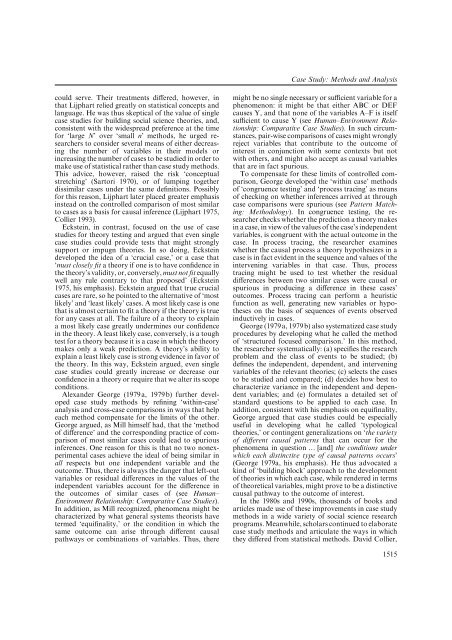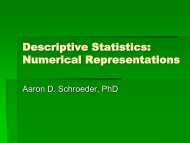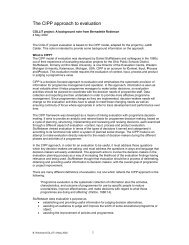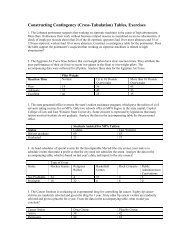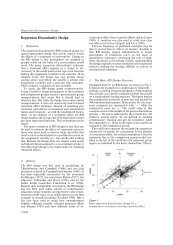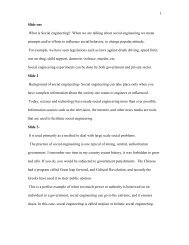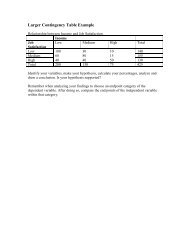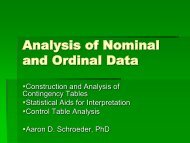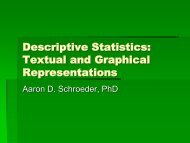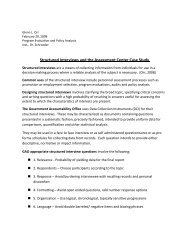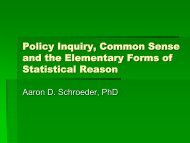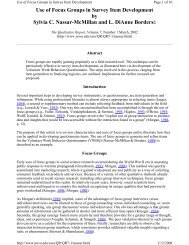Case Study: Logic
Case Study: Logic
Case Study: Logic
Create successful ePaper yourself
Turn your PDF publications into a flip-book with our unique Google optimized e-Paper software.
<strong>Case</strong> <strong>Study</strong>: Methods and Analysis<br />
could serve. Their treatments differed, however, in<br />
that Lijphart relied greatly on statistical concepts and<br />
language. He was thus skeptical of the value of single<br />
case studies for building social science theories, and,<br />
consistent with the widespread preference at the time<br />
for ‘large N’ over ‘small n’ methods, he urged researchers<br />
to consider several means of either decreasing<br />
the number of variables in their models or<br />
increasing the number of cases to be studied in order to<br />
make use of statistical rather than case study methods.<br />
This advice, however, raised the risk ‘conceptual<br />
stretching’ (Sartori 1970), or of lumping together<br />
dissimilar cases under the same definitions. Possibly<br />
for this reason, Lijphart later placed greater emphasis<br />
instead on the controlled comparison of most similar<br />
to cases as a basis for causal inference (Lijphart 1975,<br />
Collier 1993).<br />
Eckstein, in contrast, focused on the use of case<br />
studies for theory testing and argued that even single<br />
case studies could provide tests that might strongly<br />
support or impugn theories. In so doing, Eckstein<br />
developed the idea of a ‘crucial case,’ or a case that<br />
‘must closely fit a theory if one is to have confidence in<br />
thetheory’svalidity,or,conversely,mustnotfitequally<br />
well any rule contrary to that proposed’ (Eckstein<br />
1975, his emphasis). Eckstein argued that true crucial<br />
cases are rare, so he pointed to the alternative of ‘most<br />
likely’ and ‘least likely’ cases. A most likely case is one<br />
that is almost certain to fit a theory if the theory is true<br />
for any cases at all. The failure of a theory to explain<br />
a most likely case greatly undermines our confidence<br />
in the theory. A least likely case, conversely, is a tough<br />
test for a theory because it is a case in which the theory<br />
makes only a weak prediction. A theory’s ability to<br />
explain a least likely case is strong evidence in favor of<br />
the theory. In this way, Eckstein argued, even single<br />
case studies could greatly increase or decrease our<br />
confidence in a theory or require that we alter its scope<br />
conditions.<br />
Alexander George (1979a, 1979b) further developed<br />
case study methods by refining ‘within-case’<br />
analysis and cross-case comparisons in ways that help<br />
each method compensate for the limits of the other.<br />
George argued, as Mill himself had, that the ‘method<br />
of difference’ and the corresponding practice of comparison<br />
of most similar cases could lead to spurious<br />
inferences. One reason for this is that no two nonexperimental<br />
cases achieve the ideal of being similar in<br />
all respects but one independent variable and the<br />
outcome. Thus, there is always the danger that left-out<br />
variables or residual differences in the values of the<br />
independent variables account for the difference in<br />
the outcomes of similar cases of (see Human–<br />
Enironment Relationship: Comparatie <strong>Case</strong> Studies).<br />
In addition, as Mill recognized, phenomena might be<br />
characterized by what general systems theorists have<br />
termed ‘equifinality,’ or the condition in which the<br />
same outcome can arise through different causal<br />
pathways or combinations of variables. Thus, there<br />
might be no single necessary or sufficient variable for a<br />
phenomenon: it might be that either ABC or DEF<br />
causes Y, and that none of the variables A–F is itself<br />
sufficient to cause Y (see Human–Enironment Relationship:<br />
Comparatie <strong>Case</strong> Studies). In such circumstances,<br />
pair-wise comparisons of cases might wrongly<br />
reject variables that contribute to the outcome of<br />
interest in conjunction with some contexts but not<br />
with others, and might also accept as causal variables<br />
that are in fact spurious.<br />
To compensate for these limits of controlled comparison,<br />
George developed the ‘within case’ methods<br />
of ‘congruence testing’ and ‘process tracing’ as means<br />
of checking on whether inferences arrived at through<br />
case comparisons were spurious (see Pattern Matching:<br />
Methodology). In congruence testing, the researcher<br />
checks whether the prediction a theory makes<br />
in a case, in view of the values of the case’s independent<br />
variables, is congruent with the actual outcome in the<br />
case. In process tracing, the researcher examines<br />
whether the causal process a theory hypothesizes in a<br />
case is in fact evident in the sequence and values of the<br />
intervening variables in that case. Thus, process<br />
tracing might be used to test whether the residual<br />
differences between two similar cases were causal or<br />
spurious in producing a difference in these cases’<br />
outcomes. Process tracing can perform a heuristic<br />
function as well, generating new variables or hypotheses<br />
on the basis of sequences of events observed<br />
inductively in cases.<br />
George (1979a, 1979b) also systematized case study<br />
procedures by developing what he called the method<br />
of ‘structured focused comparison.’ In this method,<br />
the researcher systematically: (a) specifies the research<br />
problem and the class of events to be studied; (b)<br />
defines the independent, dependent, and intervening<br />
variables of the relevant theories; (c) selects the cases<br />
to be studied and compared; (d) decides how best to<br />
characterize variance in the independent and dependent<br />
variables; and (e) formulates a detailed set of<br />
standard questions to be applied to each case. In<br />
addition, consistent with his emphasis on equifinality,<br />
George argued that case studies could be especially<br />
useful in developing what he called ‘typological<br />
theories,’ or contingent generalizations on ‘the ariety<br />
of different causal patterns that can occur for the<br />
phenomena in question … [and] the conditions under<br />
which each distinctie type of causal patterns occurs’<br />
(George 1979a, his emphasis). He thus advocated a<br />
kind of ‘building block’ approach to the development<br />
of theories in which each case, while rendered in terms<br />
of theoretical variables, might prove to be a distinctive<br />
causal pathway to the outcome of interest.<br />
In the 1980s and 1990s, thousands of books and<br />
articles made use of these improvements in case study<br />
methods in a wide variety of social science research<br />
programs.Meanwhile,scholarscontinuedto elaborate<br />
case study methods and articulate the ways in which<br />
they differed from statistical methods. David Collier,<br />
1515


